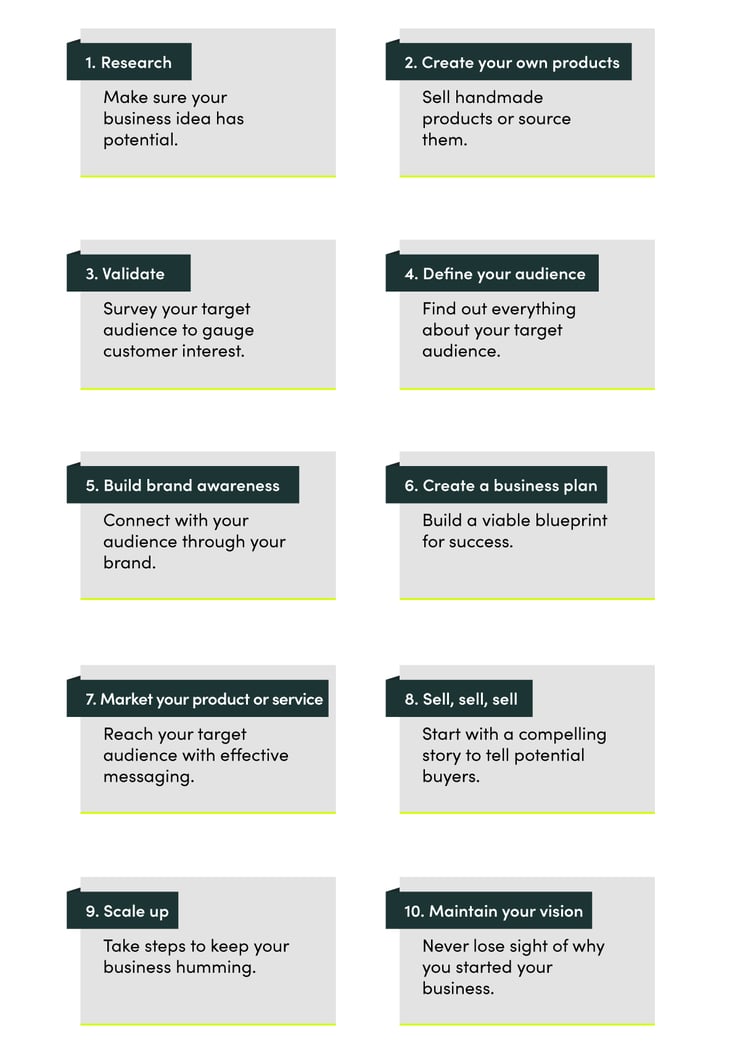Unlock the Power of Marketing: Get Your Free Marketing Plan Workbook
Enhance your marketing expertise with our free Marketing Plan Workbook, tailored specifically for small business owners...

As the saying goes, “You don’t get rich working for someone else.” In today’s constantly growing and ever-shrinking world, SMEs are driving economies, especially in Canada. The right time to start up an SME has always been now. Find out how to make your business vision, ideas, plans and goals work for you…right here.
Some of the many buzzwords and phrases cluttering the entrepreneurial universe these days—pushing the envelope, thinking outside the box, win-win situation and too many others—courage is the word you don’t hear nearly enough.
Courage is the first thing an entrepreneur needs. It’s the catalyst that sparks the idea behind starting a business. It’s the fuel your start-up SME needs to keep the engine running. And it’s the main circuit that connects every decision and action you take to keep your business running successfully from the beginning.
So, we say “bravo” if you’ve come here for advice about becoming an SME owner in Canada. It takes vision to seek help and entrepreneurial guts to follow through where others may not dare.
Why start a small business in Canada in 2023?
Good question. Rising interest rates, inflation, a looming recession... not exactly the most encouraging business climate for entrepreneurs. Historically speaking, however, SMEs have consistently shown incredible resilience and nimbleness in the face of some extraordinary challenges—even the pandemic.
Small and medium-size businesses are Canada’s backbone, employing more than two-thirds of the total labour force. Meanwhile, large businesses across the country employ only about 15%.
The power of SMEs in this country cannot be overestimated. During our last recession, SMEs helped propel Canada’s economic recovery. It’s easy to see that they will rise to the challenge again in 2023—because they are ready.
Many small businesses faced the pandemic with the kind of courage it takes to become and remain successful. It’s safe to say that those entrepreneurs were savvy enough to lay the foundation for withstanding today’s challenging economy. They laid the groundwork for protecting their core businesses while getting ready to grow in the New Year.
So, why start a small business in Canada in 2023? Because it’s an investment in your ideas, your entrepreneurial spirit and your courage.
Ten steps to launching your SME in 2023
Launching a new business is exciting and potentially rewarding. You’re the boss building a future for yourself and your family. It’s not easy when nearly 40% of new SMEs don’t last five years. You need to work hard, prepare well, stay creative and remain courageous.
It may be daunting at first but remember that millions of Canadians now run SMEs that employ most of the population. The need is there.

These 10 steps are not the definitive list, but they can help get you to your first sale.
RESEARCH: Before investing any money, make sure your business idea has the potential to succeed in a competitive world. Your idea needs to stand out, solve a problem, fill a need and attract an audience. A unique product or service and a simple business idea can end up being a bigger deal for your future than you might imagine.
CREATE YOUR OWN PRODUCTS: If you plan to sell handmade products, find an appropriate spot in your home to produce them as quickly as possible. Create enough space, set up good lighting, get the right tools and designate a storage and shipping area. If you’re sourcing your product from a manufacturer, find a supplier who will work and negotiate with you.
VALIDATE: Test your business idea before you invest too many resources. Survey your target audience or set up a webpage to gauge customer interest. Getting feedback and analyzing your business idea objectively is a valuable wake-up-and-readjust call. Listen closely to what people say about your product or service.
DEFINE YOUR AUDIENCE: You want to know every aspect of the wants, aspirations, problems, fears and needs that inspire your target audience. Do they work every day? How do they commute to work or school? Are they sports fans? Vegans? Answering these questions and others will help you identify the audience that you should target.
BUILD BRAND AWARENESS: Connect with your audience by solving their problems, sharing relatable stories, improving their lives, and making your product or service instantly recognizable. Corporations spend millions building brand awareness. SMEs can do the same for less with social media, email marketing, Instagram, Facebook ads, and other low- or no-cost social media options.
CREATE A BUSINESS PLAN: A business plan can provide you with a road map that helps you achieve your objectives. It tells potential investors and lenders you have a solid idea that may be worth their investment. A good business plan is a blueprint for success.
MARKET YOUR PRODUCT OR SERVICE: Many SME owners love this part because it requires creative thinking. This is when you use strategies and tactics to put your product or service (your brand) in front of prospective purchasers. Using tools such as advertising, social media, content marketing, video (YouTube) and ecommerce marketing can help you reach your target audience with effective messaging that sells.
SELL, SELL, SELL: Don’t panic. Some entrepreneurs are natural-born sellers—it’s in their DNA. Others (most of us) must work at it. But that work does pay off. A good business idea, a solid niche, a well-designed product and growing brand awareness are meaningless, if you don’t generate revenue. If you believe your product or service offers a benefit to your target audience, you’ve got a compelling story to tell potential buyers.
SCALE UP: You’re making money now, so scaling up your business is the next step you need to take—the one that keeps your business humming and revenues growing. Scaling up could be launching new, complementary products or services, or reducing your costs to maximize your profits.
MAINTAIN YOUR VISION: Never lose sight of why you wanted to start your business in the first place. Did you want to make more money? Did you want more free time? Did you want to control your future and be your own boss? Or did you want to help your community with a problem? These are just some of the questions you can ask yourself to align your business decisions with your vision.
Starting with next-to-no money
It’s no secret that starting a business costs money. It’s impossible to do it for free. However, you can start a business with a limited budget by applying strategic thinking and taking advantage of available low-cost or free resources.
Be prepared to work harder than an entrepreneur with money to invest.
Consider that certain start-up costs are unavoidable. For example, can you write your own business plan? Yes? You may still need to pay someone to review it.
These are just a few of the tasks that can all be done with little money, if you handle everything yourself or get help from friends and family.
Is there an alternative? Absolutely. In fact, there are hundreds of government grant and loan programs for entrepreneurs starting an SME in Canada. Plus, you can fast-track your way to small business loans and other financing solutions—via the Cubeler Business Hub™.
What about taxes?
Ah yes, the dreaded tax question. Taxes are a reality—in life and at work.
Any profession, trade or manufacturing enterprise you operate for profit is considered a business. You don’t need a physical store or employees. You can choose a full-time or part-time self-employment venture while working a regular job.
Whatever you do to generate extra revenue is taxable. As a small business owner, you must pay income tax at the federal and provincial or territorial level on the profits you generate.
In addition, you may be required to charge your customers the Goods and Services Tax (GST) or Harmonized Sales Tax (HST) and remit the funds to the Canada Revenue Agency. If your revenue over four consecutive quarters is under CA$30,000, you are not required to register for GST/HST.
What’s more, SME owners may be required to start paying taxes in quarterly instalments after their first year in business.
Six key SME trends to watch for 2023
Changing demographics and the unprecedented adoption of digital technology will challenge SME owners now and well into the future.
Today, there are six trends that entrepreneurs need to watch and embrace to help their businesses thrive:
MILLENIALS: Baby boomers are retiring (finally) and millennials are ready and anxious to dominate the work world. Social media is the virtual job fair to find strong talent and promote your business as a great place to work. Reach out to schools, offer internships and invest in training.
SHRINKING LABOUR POOL: With baby-boom retirements, the labour pool is expected to grow more slowly, and even shrink. Older workers are still valuable assets, so offering flexible hours, part-time and temporary work can keep them on board while attracting millennials who can learn from them.
DIVERSITY: Immigrants will be essential in a tight labour market. Start recruiting from immigrant communities through business associations and networks. Customize your training to this group and look for the strengths that immigrants can offer to increase your SME’s capacity within Canada and abroad.

VIRTUAL MARKETPLACE: Consumers are spending more of their money online than anywhere else. Create a digital ecosystem for your SME with a mobile-friendly website, e-commerce capability and social media. Launch simple, cost-effective promotional campaigns via Facebook ads or Google AdWords to drive traffic to your site and increase your marketing ROI.
AUTOMATION: Robots and AI offer time- and money-saving solutions for a wide range of business services and operations. There’s no need to buy a robot. Automation tech systems such as ERP and CRM are designed to boost productivity and reduce costs. Look for ways your SME can automate. Get your employees involved to encourage them to embrace new ideas.
DATA ECONOMY: The value of business data cannot be overestimated. SMEs can now collect massive amounts of data to grow their businesses. Understand your customers better and take advantage of online opportunities with surveys, data analytics programs and social media monitoring software. Plus, data will help you personalize your products or services and increase sales.
Get more details on the BDC survey here.
Best small business ideas for 2023
You can imagine what happens when you type “best small business ideas for 2023” in your Google search bar. You get a carnival of listings with hundreds of business ideas that are “sure-fire winners.” They may be, but we cherry-picked what we consider to be 10 very promising, low-investment business ideas for 2023 and beyond.
Start a dropshipping business. With this low-cost start-up idea, you can use a proven third-party supplier to warehouse and ship products to your customers. Dropshipping is a low-overhead, hands-off and scalable business. You don’t handle any of the products. You simply do the selling, and your supplier does the rest.
Create digital products or online courses. Music, tutorials and podcasts are some of the unique, low-investment small-business ideas you can explore. There are no ongoing manufacturing or shipping costs, so margins can be high. What makes a good digital product? Anything from original instrumental beats to licensable images and online courses that help people pursue their passions or develop new skills.
Sell print-on-demand t-shirts, posters, greeting cards and prints. If you’re creative with graphic design or a camera, you can start a print-on-demand SME to sell your work. As long as you have the copyright to the content or you use public-domain resources, you can freely monetize your creations.
Sell handcrafted and homemade goods. Are you a crafter? If you can make giftable soaps, pottery, candles, unique sauces or more, your small business idea is literally in your hands—and virtually out there making you money. You’ll need to think about managing inventory and shipping, but it would be easy to start on a per-order basis or with small batches until word of mouth or low-cost social media advertising starts generating sales.
Start a pet business. People love their pets like family. It’s a $100-billion industry ready for all sorts of small-business ideas and there’s a ton of demand. You could sell accessories, food, toys, novelty items (hats for cats?) or provide walking, pet sitting, grooming or training services. If you love your pets like your customers do, you’re about to start a few thousand long-term relationships that can really pay off!
Join an affiliate marketing program. Affiliate marketing is a service that offers you the opportunity to earn a commission—just for selling the products or services of retailers or advertisers through an affiliate link on your site. Most affiliate programs are free to join and can take you from a side hustle to a profitable online business with a sizable income.
Become a virtual event planner. If you have a talent for organizing and connecting people, this may be your niche SME. This industry is growing at nearly 25% per year, and the increase in business events and virtual tools for conducting meetings are set to keep it growing. As a virtual event planner, you can create networking opportunities, educational sessions and virtual conferences for companies all over the globe.
Start a landscaping business. If you enjoy nature and design, combining these two passions can lead to an excellent opportunity. Beautifying landscapes with flowers, grass and trees is bound to be a satisfying and rewarding way to exercise your creativity and your love for nature. And while the demand for residential outdoor landscape maintenance is growing, competition in this field (pun intended) is moderate.
Become a social media management consultant. Last year, nearly 60% of the world’s population were active social media users. When marketing their products and services on YouTube, Instagram, Facebook, TikTok and other social media networks, brands need help managing their accounts. And only the big companies can afford to have that help on staff. That means there are potential clients who will pay you to create content, write bios, answer comments, place ads and so much more.
Offer housesitting and pet sitting services. Travel is once again on the rise, and with that comes a need for home and pet care. When you consider the increase in remote work, extended vacations are becoming routine. If you’re comfortable caring for a stranger’s home and/or pets, housesitting and pet sitting can make for a thriving SME. Create a confident, caring and professional social media profile. Talk about your experience in home and pet care, including your qualifications or certifications to set you apart from your competition.
What’s the outlook for 2023?
According to a recent BDC report, “the next few months will be difficult for entrepreneurs in Canada, who cite rising costs (47%), the economic slowdown (40%) and internal cost control as the main obstacles to their activities. Over the next 12 months, SMEs still plan to invest and prioritize operational efficiency (38%) over growth projects and debt repayment.”
This is actually a positive outlook—if you’re about to start an SME. Your colleagues and competitors are ready for the challenges that 2023 will bring. The BDC reports that “... 45% of SMEs do not fear for their profitability and estimate their sales will be similar to what they were last year (42%). Three-quarters are comfortable with their current level of debt.”
It’s all about courage
Every business, small and supersized, comes with a certain level of risk—some can be predicted, and others come at you like a runaway freight train out of nowhere.
Of course, the key to success is (and has always been) smart planning, good research, solid ideas, knowing your audience and working hard every day.
But the one thing every SME owner needs in huge quantities is courage. You need to believe in yourself and your decisions, even when times are tough, to drive your business to long-term success.
Quick Takeaways
An SME start-up is a bold step forward in taking charge of your future. It’s rarely free, it’s not always easy and it’s not a guaranteed success. But the effort and time you dedicate to your venture can lead to a long-term adventure that redefines your life.
Starting an SME can be an exciting experience if you keep these realities in mind:

Enhance your marketing expertise with our free Marketing Plan Workbook, tailored specifically for small business owners...

Find out what you need to know to bypass the most common marketing pitfalls.

Expand your SME business network the right way. Learn how to connect with like-minded SME owners and decision-makers to...